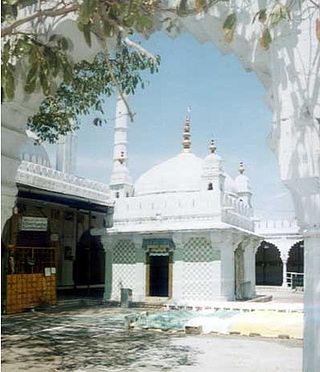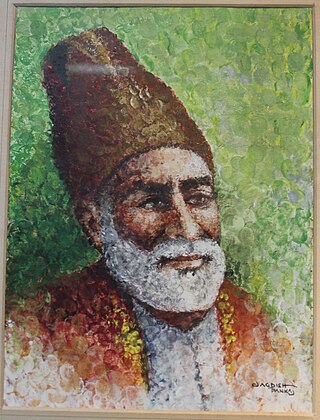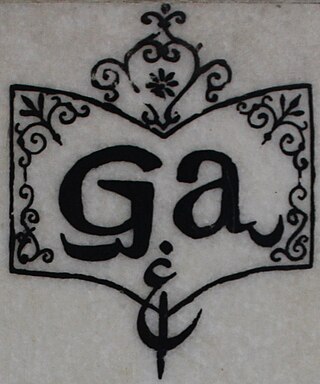
The Chishti order is a Sufi order of Sunni Islam named after the town of Chisht, Afghanistan where it was initiated by Abu Ishaq Shami. The order was brought to Herat and later spread across South Asia by Mu'in al-Din Chishti in the city of Ajmer.

Abu'l Hasan Yamīn ud-Dīn Khusrau, better known as Amīr Khusrau, sometimes spelled as, Amir Khusrow or Amir Khusro, was an Indo-Persian Sufi singer, musician, poet and scholar, who lived during the period of the Delhi Sultanate.

Khawaja Syed Muhammad Nizamuddin Auliya, also known as Hazrat Nizamuddin, Sultan-ul-Mashaikh and Mahbub-e-Ilahi, was an Indian Sunni Muslim scholar, Sufi saint of the Chishti Order, and is one of the most famous Sufis from the Indian Subcontinent. His predecessors were Fariduddin Ganjshakar, Qutbuddin Bakhtiyar Kaki, and Moinuddin Chishti, who were the masters of the Chishti spiritual chain or silsila in the Indian subcontinent.

Humayun's tomb is the tomb of Mughal emperor, Mirza Nasir al-Din Muhammad commonly known as Humayun situated in Delhi, India. The tomb was commissioned by Humayun's first wife and chief consort, Empress Bega Begum under her patronage in 1558, and designed by Mirak Mirza Ghiyas and his son, Sayyid Muhammad, Persian architects chosen by her. It was the first garden-tomb on the Indian subcontinent, and is located in Nizamuddin East, Delhi, close to the Dina-panah Citadel, also known as Purana Qila, that Humayun found in 1538. It was also the first structure to use red sandstone at such a scale. The tomb was declared a UNESCO World Heritage Site in 1993, and since then has undergone extensive restoration work, which is complete. Besides the main tomb enclosure of Humayun, several smaller monuments dot the pathway leading up to it, from the main entrance in the West, including one that even pre-dates the main tomb itself, by twenty years; it is the tomb complex of Isa Khan Niazi, an Afghan noble in Sher Shah Suri's court of the Suri dynasty, who fought against the Mughals, constructed in 1547 CE.
Sarai Kale Khan is an urban village in the South East Delhi district of Delhi. The area is well-connected to the rest of Delhi through the Delhi Metro's Pink Line and a nearby Inter-State Bus Terminus (ISBT), offering convenient transportation options. Located next to Hazrat Nizamuddin Railway Station on the Indian Railways network, this station serves as one of Delhi's five main railway hubs and operates as both the originating and terminal station for 60 trains. The ISBT functions as a terminus for most buses heading to cities and towns south of Delhi and includes a DTC bus depot, supporting the Mudrika Seva and various other bus routes.

Hazrat Nizamuddin Dargah is the dargah (mausoleum) of the Sufi saint Khwaja Nizamuddin Auliya. Situated in the Nizamuddin West area of Delhi, the dargah is visited by thousands of pilgrims every week. The site is also known for its evening qawwali devotional music sessions.

Shaykh Syed Sharfuddin Bu Ali Shah Qalandar Panipati, renowned as Bu Ali Qalandar, born in Panipat, Delhi Sultanate, present-day Haryana, India, was a Qalandar and Sufi saint of the Owaisī Order, who lived and taught in India. His dargah (Shrine) is located in Panipat, and is a place of pilgrimage for his followers.

Khuldabad is a city and a Taluka of Aurangabad district in the Indian state of Maharashtra. It is known as the Valley of Saints, or the Abode of Eternity, because in the 14th century, several Sufi saints chose to reside here. The Bhadra Maruti Temple and Dargah of Zar Zari Zar Baksh, Shaikh Burhan ud-din Gharib Chisti and Shaikh Zain-ud-din Shirazi, along with the tomb of the Mughal emperor Aurangzeb and his trusted General Asif Jah I, the first Nizam of Hyderabad, are located in this town. It is a holy and spiritual city of Islamic saints.

Nasiruddin Mahmud Chirag-Dehlavi was a 14th-century mystic-poet and a Sufi saint of the Chishti Order. He was a disciple of Sufi saint Nizamuddin Auliya, and later his successor. He was the last important Sufi of the Chishti Order from Delhi.

Chausath Khamba, also spelled Chaunsath Khamba, is a tomb built during 1623–24. It is located in Nizamuddin precincts of Sufi Muslim shrines and tombs in New Delhi, India. The name means "64 pillars" in Urdu and Hindi. It was built by Mirza Aziz Koka, son of Ataga Khan, as a mausoleum for himself, at the time when Mughal Emperor Jahangir ruled from Delhi. Mirza Aziz Koka had served several times as Jahangir’s Governor of Gujarat before he died in Gujarat.

Jamali Kamali Mosque and Tomb, located in the Archaeological Village complex in Mehrauli, Delhi, India, comprise two monuments adjacent to each other; one is the mosque and the other is the tomb of Jamali and Kamali. Their names are tagged together as "Jamali Kamali" for the mosque as well as the tomb since they are buried adjacent to each other. The mosque and the tomb were constructed in 1528-1529, and Jamali was buried in the tomb after his death in 1535.

Burhanuddin Gharib was an Indian Sufi of the Chishti Order. He was one of the caliphs of the Sufi Saint Nizamuddin Awliya.

Ajmer Sharif Dargah is a Sufi Tomb (dargah) of the Sufi saint, Khwaja Moinuddin Hasan Chishti, located at Ajmer Shareef, Rajasthan, India.

ʿUthmān Sirāj ad-Dīn al-Bangālī , known affectionately by followers as Akhi Siraj, was a 14th-century Bengali Muslim scholar. He was a Sufi belonging to the Chishti Order and was a disciple of Nizamuddin Auliya of Delhi. As one of the senior disciples of Nizāmuddīn Auliyā, he spent long years with him in Delhi and earned the sobriquet of Āinā-e-Hind. His shrine, the Pirana Pir Dargah in Gaur, West Bengal, attracts hundreds of thousands of devotees every year. Siraj and his successor, Alaul Haq, are credited with the rise to prominence of the Chishti order in Bengal.

Mirza Ghalib Museum, New Delhi is a museum on the life and times of the 18th century Urdu poet Mirza Ghalib, under the aegis of the Ghalib Academy, New Delhi. The museum is situated in the vicinity of the tomb of the 13th century Sufi saint Khwaja Nizamuddin.

Ghalib Academy (Urdu: غالب اکادمی ) is an educational and cultural institution of national importance in India. It was founded in 1969 by Hakeem Abdul Hameed and inaugurated by the former president of India Dr. Zakir Hussain in Nizamuddin West area, Delhi. The Academy has been established in the memory of the 19th century Urdu poet Mirza Ghalib. The Academy is situated in the vicinity of the tomb of the 13th-century Sufi saint Nizamuddin Auliya.

Persian Inscriptions on Indian Monuments is a book written in Persian by Dr Ali Asghar Hekmat E Shirazi and published in 1956 and 1958 and 2013. New edition contains the Persian texts of more than 200 epigraphical inscriptions found on historical monuments in India, many of which are currently listed as national heritage sites or registered as UNESCO world heritage, published in Persian; an English edition is also being printed.

The tomb of the noble Isa Khan Niazi is located in the Humayun's Tomb complex in Delhi, India. The mausoleum, octagonal in shape and built mainly of red sandstone, was built in 1547–1548 during the reign of Sher Shah Suri. The mosque of Isa Khan is located west of the mausoleum, which along with other buildings form the UNESCO World Heritage Site of Humayun's tomb complex.

Khwaja Hasan Sani Nizami was a Sufi Shaykh of Nizami branch of Chishti Order and the former Sajjadanasheen of Nizamuddin Auliya's shrine and considered as a prominent figure of Urdu literature. He was a member of United Nations Religious Initiatives, San Francisco of United States of America. He was the son of Khwaja Hasan Nizami and the master of Iqbal Ahmad Khan.


















